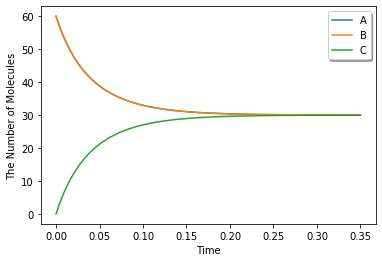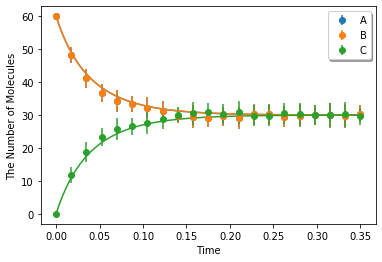See also
This page was generated from tests/Reversible_Diffusion_limited.ipynb.
Download the Jupyter Notebook for this section: Reversible_Diffusion_limited.ipynb. View in nbviewer.
Reversible (Diffusion-limited)¶
This is for an integrated test of E-Cell4. Here, we test a simple reversible association/dissociation model in volume.
[1]:
%matplotlib inline
from ecell4.prelude import *
Parameters are given as follows. D, radius, N_A, U, and ka_factor mean a diffusion constant, a radius of molecules, an initial number of molecules of A and B, a ratio of dissociated form of A at the steady state, and a ratio between an intrinsic association rate and collision rate defined as ka andkD below, respectively. Dimensions of length and time are assumed to be micro-meter and second.
[2]:
D = 1
radius = 0.005
N_A = 60
U = 0.5
ka_factor = 10 # 10 is for diffusion-limited
[3]:
N = 20 # a number of samples
Calculating optimal reaction rates. ka and kd are intrinsic, kon and koff are effective reaction rates.
[4]:
import numpy
kD = 4 * numpy.pi * (radius * 2) * (D * 2)
ka = kD * ka_factor
kd = ka * N_A * U * U / (1 - U)
kon = ka * kD / (ka + kD)
koff = kd * kon / ka
Start with no C molecules, and simulate 3 seconds.
[5]:
y0 = {'A': N_A, 'B': N_A}
duration = 0.35
opt_kwargs = {'legend': True}
Make a model with effective rates. This model is for macroscopic simulation algorithms.
[6]:
with species_attributes():
A | B | C | {'radius': radius, 'D': D}
with reaction_rules():
A + B == C | (kon, koff)
m = get_model()
Save a result with ode as obs, and plot it:
[7]:
ret1 = run_simulation(duration, y0=y0, model=m)
ret1.plot(**opt_kwargs)

Make a model with intrinsic rates. This model is for microscopic (particle) simulation algorithms.
[8]:
with species_attributes():
A | B | C | {'radius': radius, 'D': D}
with reaction_rules():
A + B == C | (ka, kd)
m = get_model()
Simulating with spatiocyte. voxel_radius is given as radius. Use alpha enough less than 1.0 for a diffusion-limited case (Bars represent standard error of the mean):
[9]:
# alpha = 0.03
ret2 = ensemble_simulations(duration, ndiv=20, y0=y0, model=m, solver=('spatiocyte', radius), repeat=N)
ret2.plot('o', ret1, '-', **opt_kwargs)

Simulating with egfrd:
[10]:
ret2 = ensemble_simulations(duration, ndiv=20, y0=y0, model=m, solver=('egfrd', Integer3(4, 4, 4)), repeat=N)
ret2.plot('o', ret1, '-', **opt_kwargs)
